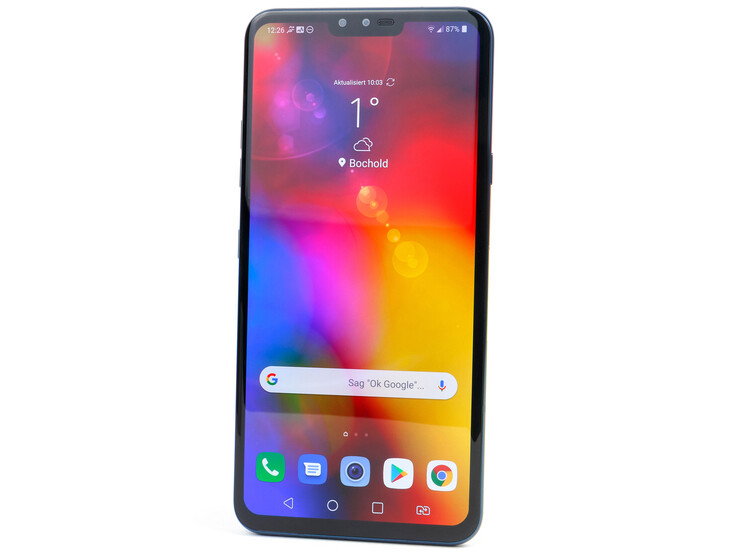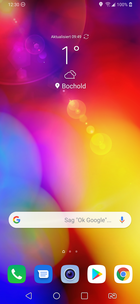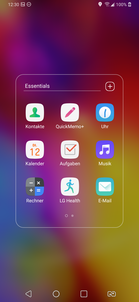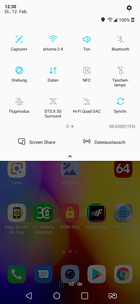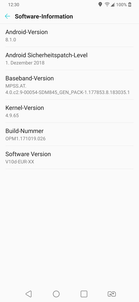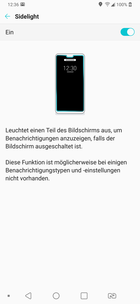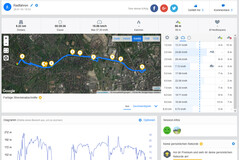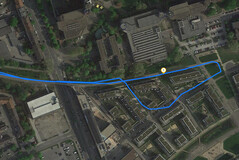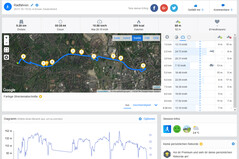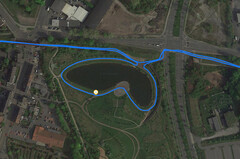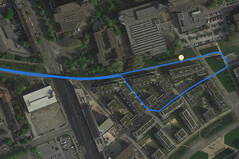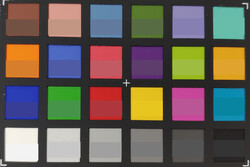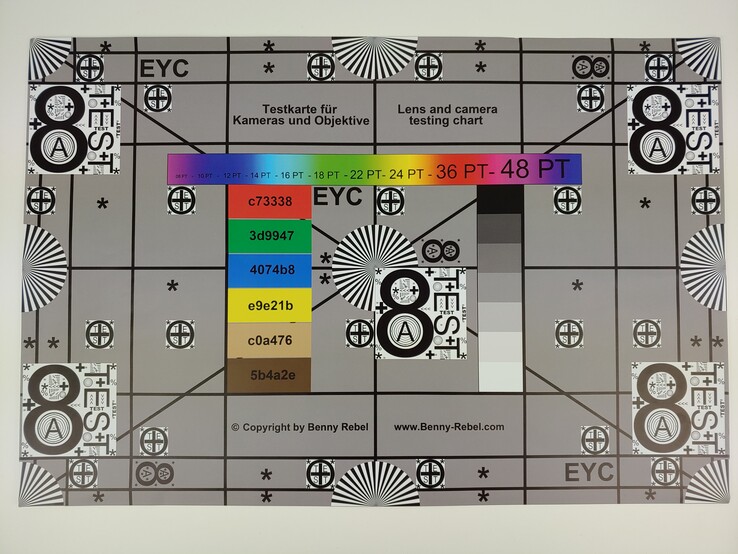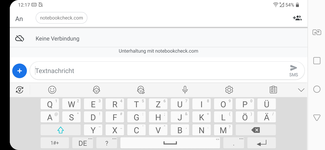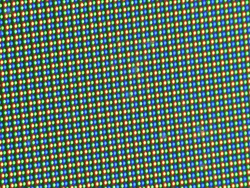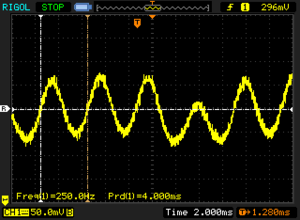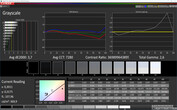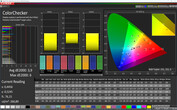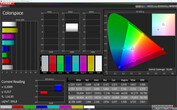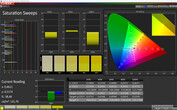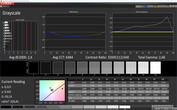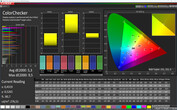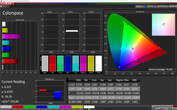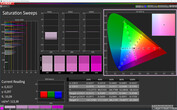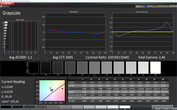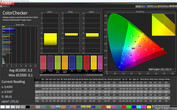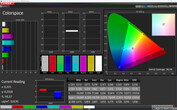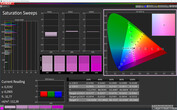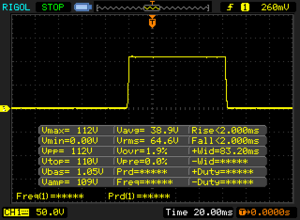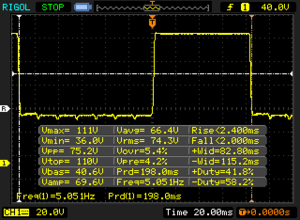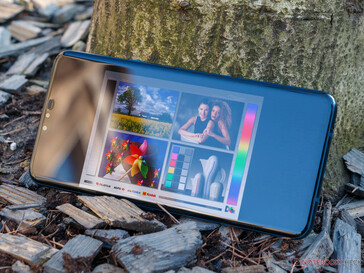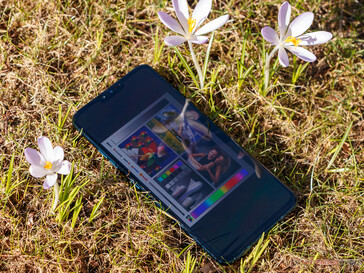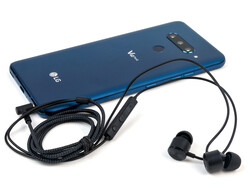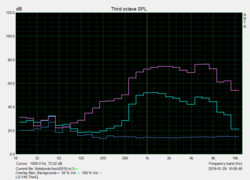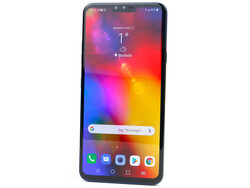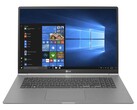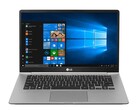LG V40 ThinQ Smartphone Review
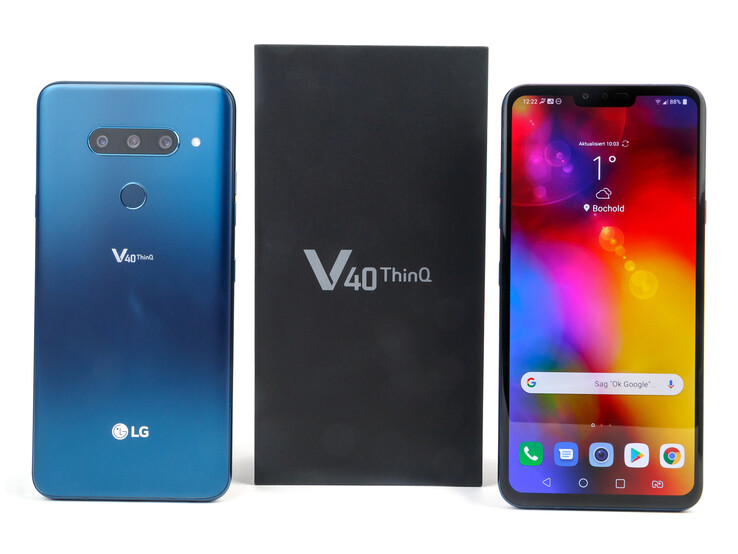
LG first announced the V40 ThinQ in October last year, but it has taken over three months for the South Korean manufacturer’s latest flagship to arrive in Germany. Three months may not sound like a long time, but it is in the world of smartphones. Mobile World Congress 2019 is only a few days away, at which LG will announce the G8 ThinQ, which we expect to be equipped with a more powerful SoC and a newer version of Android than the V40. Hence, the latest smartphone in LG’s V series is almost already outdated just as it has arrived in Europe.
The V40 is a flagship smartphone typical of those released last year. The Qualcomm Snapdragon 845 powers the device, which is complemented by 6 GB of RAM. Moreover, the V40 has 128 GB of UFS 2.1 internal storage that can be expanded with up to 2 TB microSD cards. However, the V-series continues to stand out from its peers with a 32-bit Hi-Fi Quad DAC, the first incarnation of which we saw with the LG V10. The V40 also has a headphone jack, which has become something of a rarity among modern flagship smartphones.
The star of the show for the V40 is its five cameras. The device has two front-facing cameras and three on the back, which should provide most people with enough flexibility to take almost any shot. The smartphone is dustproof and waterproof too, while it has an OLED display like its predecessor. The 3,300 mAh battery remains unchanged though, which is rather small by today’s standards.
The V40 succeeds the LG V30, which scored highly in our review for its bright display, its decent battery life and its impressive main camera. However, we were disappointed to see a USB 2.0 Type-C port, pulse-width modulation (PWM) display flicker and poor viewing angles. Please keep in mind that LG also released the V30s ThinQ and V35 ThinQ, but we did not review these as they were only minor revisions on the V30.
We have chosen to compare the V40 against other flagship smartphones released in the last year. Our comparison device will include the Apple iPhone XS Max, the Honor View 20, the Huawei Mate 20 Pro, Samsung Galaxy S9+, Xiaomi Mi Mix 3 and the ZTE Axon 9 Pro. The V40 currently retails for €899 (~$1,019) in Germany, which makes it more expensive than our comparison devices, which are all cheaper or have reduced in price since their release. We expect that the V40 will soon become cheaper too, but this may take a few months.
Case
The V40 looks boringly unremarkable in photos. However, do not let these put you off as the device looks far better in person. LG currently sells the V40 in New Moroccan Blue and Silver, both of which look stylish. The device is covered in Corning Gorilla Glass 5, which we like to see in more smartphones as it has a matte finish that hardly picks up any fingerprints.
The V40 also feels good in the hand and is comparatively light. The case is thin too, but our review unit is 0.3 mm (~0.01 in) thicker at its thickest point than LG’s official specifications. The V40 is also a hair thicker than the LG V30, although it is thinner than most of our comparison devices. It is worth keeping in mind that the rear-camera housing protrudes by 0.5 mm (~0.02 in) from the back glass, but we had no issues with this in daily use.
Our review unit is well made too, while LG’s extensive use of aluminium and glass helps to make the device feel current. The gaps between materials are mostly even and tight. However, there is a slightly bigger gap along one of the long sides of our review unit between the back glass and the frame than on the rest of the device. Our attempts to twist the V40 were in vain though, as it did not creak or flex regardless of how hard we applied pressure to the case.
The battery is firmly installed as is the case with many modern smartphones, which allows the V40 to be IP68 certified against dust and water. The card slot sits flush with and matches the colour of the frame of our review unit too. The slot is made from plastic and has space for either two nano-SIM cards or a microSD card instead of the second nano-SIM.
The V40 is also MIL-STD-810G1 certified, which means that it successfully passed 14 environmental and climatic tests. These include falls from up to 1.2 metres (~4 ft) along with being subjected to -33 °C (~-27 °F) for four hours and to -21 °C (~-6 °F) for 24 hours. There are also salt spray, high humidity, high temperature, high pressure, sunlight and vibration tests. Please keep in mind that no independent organisation or agency certifies MIL-STD-810 compliance, so take the certification with a pinch of salt.
Connectivity
The V40 supports expandable storage, which is by no means a given for flagship smartphones. The device supports up to 2 TB microSD cards and all modern file systems including exFAT. We could store apps and data on our reference microSD card, but we could not format it as an internal storage. This should have no practical implications though.
Unfortunately, LG has persisted with equipping its V series devices with a USB 2.0 Type-C port rather than using a faster USB 3.1 equivalent. The port still supports USB On-The-Go (OTG) for if you would like to connect peripherals such as a mouse and keyboard, but we could not get our review unit to output video via a wired connection
The V40 lacks a notification LED like many of its competitors, but it does have an always-on-display like its predecessor and edge lighting like Samsung used in the Galaxy S9.
The device also has an NFC chip, and support for Bluetooth 5.0 along with ac Wi-Fi. LG has included Qi wireless charging too, but there no IR blaster or FM radio support like some Huawei flagships have. In short, the V40 has the same connectivity as the LG V30 and adds nothing new.
Software
LG has a poor reputation of delivering OS updates, particularly with its V series. The company only updated the V20 to Android 8.0 Oreo late last year, and initially announced that it would not roll-out an Android 9 Pie update before seemingly backtracking on this. The company has opened a Software Update Center at its R&D facility in South Korea, but the LG V40 ships with Android 8.1 Oreo at the time of writing, which Google originally released in December 2017. LG has promised to update the V40 to Android 9.0 Pie at the beginning of Q2, but it remains to be seen whether the company will keep to this deadline.
Our review unit arrived with outdated security patches too, but we should point out that it is running different firmware to that which retail units have, so they should have newer security patches installed and should receive updates more quickly than our unit. We hope that LG updates the V40 to Android Q at some point, but we would not bank on that happening any time soon.
LG overlays its UI over 8.1 Oreo, but it makes only minor changes from stock Android. The company includes a different icon pack and re-arranges the Settings menu to accommodate its custom features, but most people should quickly acclimatise if they have used Android before.
The V40 supports multiple user accounts like most modern Android smartphones. Our review unit has numerous Google and LG apps pre-installed too, of which only a few are uninstallable. There is no desktop mode either like we have seen Huawei and Samsung implement with their recent flagship smartphones, but this is only a minor gripe.
Communication & GPS
The V40 supports fast Cat. 18 LTE, while the European variant supports all important LTE bands for China, Europe, Russia and the United States. Our review unit maintained a solid mobile network connection throughout our tests too.
There are also no problems with Wi-Fi connectivity. The V40 supports up to IEEE 802.11 ac Wi-Fi and connect to 2.4 or 5.0 GHz networks. LG has equipped the device with a MIMO antenna that allowed it to achieve decent transfer speeds in our iperf3 Client Wi-Fi tests. It is worth noting that the LG V30 averaged better transfer speeds in our tests than its successor, but most people will not notice the difference in daily use. The V40 also experienced some minor slowdowns in our Wi-Fi transmission test, but these should go unnoticed in daily use too.
The V40 uses BeiDou, GALILEO, GPS, GLONASS and QZSS for location services, which helps it achieve fast satellite fixes outdoors. Our review unit maintained a sat fix with up to 3 metres (~10 ft) accuracy when tested outdoors, which dropped to 6 metres (~20 ft) indoors. Overall, the V40 should have no issues with locating you wherever you are.
We also took our test device on a short bike ride to compare its location accuracy against a professional navigation system. We used our trusty Garmin Edge 500 for this test, which surprisingly did a worse job than the V40 did at plotting our route, as demonstrated by the screenshots below. Our review unit recorded a more natural looking route than the Garmin did, so the V40 should not let you down during general navigation tasks.
Telephone Features & Call Quality
LG has pre-installed its phone app on the V40, which is well laid out and is largely unchanged from the one that the company used on the V30. Our review unit has excellent call quality when using the earpiece, but voices sound too tiny on speakerphone for our liking.
The V40 supports VoLTE and VoWiFi too, but your carrier must provision the device before either technology works. VoLTE and VoWiFi will not necessarily work out of the box.
Cameras
The V40 treads a similar path to the Pixel 3 XL with its dual front-facing camera, but thankfully the former has a much smaller and less obtrusive notch. The main camera is an 8 MP sensor that takes comparable shots to the front-facing camera in the LG G7 ThinQ. There is also a 5 MP wide-angle camera, but we only noticed the added width when we outstretched our arm, so its utility is rather limited.
LG markets the V40 heavily on the strengths of its cameras and has equipped the device with three rear-facing cameras to distinguish it from other flagships. We have already seen Huawei do this with the P20 Pro and Mate 20 Pro though, while Samsung has just announced the Galaxy S10 and S10+, both of which have 3 rear-facing cameras.
The V40 has a 12 MP regular sensor that has an f/1.5 aperture and a 1.4 µm pixel size. LG complements this with a 16 MP ultra-wide-angle sensor and a 12 MP telephoto lens that supports up to 2x optical zoom. There is also a triple-shot function that triggers all cameras simultaneously and allows you to choose from the best picture. Our review unit took a while to capture all three images, but it worked well during our tests. The V40 can combine all three pictures into a short video too that is saved as a 6 second, 1080p, MP4 video.
Triple shot at night
Triple shot by day
Photos shot during the day look good in isolation, but the V40 struggles in some areas compared to the Apple iPhone XS and the ASUS ROG Phone. Taking scene 1 as an example, the photo taken with the V40 looks detailed and colour accurate. However, the colours are noticeably duller than in the shots taken with our comparison devices, while details are muddier too. The V40 does a much better job in scene 2, which is a macro shot. Again though, our review unit cannot capture all the fine details that our comparison devices manage to do. The V40 produces natural looking photos at night too, which are more detailed and better exposed than the equivalent photo that the iPhone XS takes. The ROG Phone also just wins here though in our opinion.
The V40 can record videos in up to Ultra HD at 60 FPS, but only 6 minutes and without image stabilisation. Navigating the default camera app is too convoluted for our liking, but the manual video mode is excellent once you find it and allows you to set the frame rate at 1, 2, 24, 30 or 60 FPS. Moreover, you can enable Hi-Fi sound and HDR10 video, which should provide improved audio and image quality compared to stock settings. Enabling HDR10 disables the zoom functionality with the ultra-wide-angle lens though. Overall, the V40 produces excellent looking and sounding videos, but we would recommend using HDR sparingly as it only works well in good ambient light. In short, the V40 has one of the most versatile video cameras of any smartphone, and its additional lens gives it an advantage over the V30.
We also subjected the triple camera array to further tests under controlled light conditions. All sensors are pleasingly colour accurate, although skin and grey tones are too bright and warm for our liking. Other colours are also highly saturated, but not offputtingly so.
Our review unit captures our test chart sharply too, although the sharpness and contrast visibly decrease towards the edges of the photo. Although the telephoto lens produces more vibrant looking photos, the drop in contrast is more pronounced than the regular camera. The ultra-wide-angle sensor produces the most consistent looking photo of the three in our opinion with the contrast dropping off only in the bottom right-hand corner. All three cameras reproduce colour gradients cleanly, with dark fonts on a dark background only being a problem for the ultra-wide-angle sensor.
Accessories & Warranty
The V40 comes with a 9 W charger (5 V/1.8 A), a USB Type-A to Type-C cable and a pair of headphones. There is also a SIM tool, a microfibre cloth and a quick start guide.
The device comes with 24 months warranty, but the warranty period can be extended to up to four years with LG Premium Care, which costs €100 (~$113) or €2.69 (~$3.05) per month. The latter offers greater flexibility in our opinion as LG allows you to cancel the service whenever you like.
The company offers an optional premium protection plan too, which covers against breakages, drops and liquid damage, but you must purchase it within 14 days of receiving your device. The premium protection costs €135 (~$153) for one-years coverage or €270 (~$306) for two years. You can also pay for this coverage monthly, which currently costs €11.99 (~ US$13.60).
Please see our Guarantees, Return policies and Warranties article for more country-specific information.
Input Devices & Operation
The V40 has a capacitive touchscreen, which is protected by Corning Gorilla Glass 5 that feels smooth to the touch. Our review unit reliably recognised inputs throughout our tests. LG has made no major changes to the keyboard layout from previous smartphones. You can replace it with another from the Google Play Store should you not like the stock one.
The Google Assistant button is new to the V series, which sits on the left-hand side of the frame and opens the service when the device is unlocked. We could not disable the button during our tests, but it is possible to link it to other digital assistants within Settings. These must be installed before you can enable them though
LG has kept the fingerprint sensor on the back of the device, which worked perfectly during our time with the device. The V40 unlocks quickly using the fingerprint sensor, but you could use the less secure 2D face recognition should you wish, which also unlocks the device promptly. It is worth noting that LG has equipped the V40 with a dedicated power button, rather than integrating it within the fingerprint reader as they did with the V20 and the V30.
Display
The V40 has a 6.4-inch OLED display that operates natively at 1440p and is 0.4-inches larger than the one in the V30. LG promises to have improved the display technology, which corresponds with our results. The screen in the V40 is brighter than its predecessor and achieves an average maximum brightness of 559 cd/m² with the ambient light sensor activated according to X-Rite i1Pro 2, which is 23% brighter than the V30. This value rose to just under 780 cd/m² when we tested the V40 with the more realistic APL50 test. The black level is also theoretically perfect because it can individually switch off pixels, which also results in a theoretically infinite contrast ratio.
LG integrates a blue light filter and an always-on display just as it did with the V30. Unfortunately, the display uses pulse-width modulation (PWM) to regulate its brightness, but that is a problem for all OLED panels as they do not have a dedicated backlight. Please note that we measured a 250 Hz PWM frequency across the whole brightness spectrum, which could cause eye strain and headaches for some people. Thankfully, our review has a pleasantly low minimum brightness, which should make the V40 easy to read at night.
| |||||||||||||||||||||||||
Brightness Distribution: 89 %
Center on Battery: 567 cd/m²
Contrast: ∞:1 (Black: 0 cd/m²)
ΔE Color 3.3 | 0.5-29.43 Ø5
ΔE Greyscale 1.1 | 0.57-98 Ø5.3
96.5% sRGB (Calman 2D)
Gamma: 2.46
| LG V40 ThinQ OLED, 3120x1440, 6.40 | LG V30 OLED, 2880x1440, 6.00 | Samsung Galaxy S9 Plus Super AMOLED, 2960x1440, 6.20 | Huawei Mate 20 Pro OLED, 3120x1440, 6.30 | Apple iPhone Xs Max OLED, 2688x1242, 6.50 | ZTE Axon 9 Pro AMOLED, 2248x1080, 6.21 | |
|---|---|---|---|---|---|---|
| Screen | -83% | -2% | 11% | 13% | -22% | |
| Brightness middle | 567 | 432 -24% | 565 0% | 576 2% | 656 16% | 521 -8% |
| Brightness | 559 | 428 -23% | 571 2% | 582 4% | 659 18% | 517 -8% |
| Brightness Distribution | 89 | 87 -2% | 96 8% | 90 1% | 88 -1% | 96 8% |
| Black Level * | ||||||
| Colorchecker dE 2000 * | 3.3 | 4.18 -27% | 2.3 30% | 1.3 61% | 1.7 48% | 2.9 12% |
| Colorchecker dE 2000 max. * | 6.1 | 8.53 -40% | 4.8 21% | 3.5 43% | 2.8 54% | 5.5 10% |
| Greyscale dE 2000 * | 1.1 | 5.3 -382% | 1.9 -73% | 1.6 -45% | 1.7 -55% | 2.7 -145% |
| Gamma | 2.46 89% | 2.33 94% | 2.16 102% | 2.18 101% | 1.998 110% | 2.01 109% |
| CCT | 6495 100% | 7487 87% | 6332 103% | 6561 99% | 6487 100% | 6288 103% |
* ... smaller is better
Screen Flickering / PWM (Pulse-Width Modulation)
| Screen flickering / PWM detected | 250 Hz | ≤ 99 % brightness setting | |
The display backlight flickers at 250 Hz (worst case, e.g., utilizing PWM) Flickering detected at a brightness setting of 99 % and below. There should be no flickering or PWM above this brightness setting. The frequency of 250 Hz is relatively low, so sensitive users will likely notice flickering and experience eyestrain at the stated brightness setting and below. In comparison: 53 % of all tested devices do not use PWM to dim the display. If PWM was detected, an average of 17933 (minimum: 5 - maximum: 3846000) Hz was measured. | |||
LG has drastically improved the colour accuracy of the V40’s display compared to the one that it used in the V30. We examined the colour accuracy with a photo spectrometer and CalMAN analysis software, which determined that the V40 reproduces grey tones more accurately than our comparison devices. You must select the cinema colour mode for the best colour reproduction though. By contrast, the automatic mode has a slight blue to it. The V40 also has lower mixed colour deviations than the V30, but it is beaten by most of our comparison devices in this regard.
Display Response Times
| ↔ Response Time Black to White | ||
|---|---|---|
| 4 ms ... rise ↗ and fall ↘ combined | ↗ 2 ms rise | |
| ↘ 2 ms fall | ||
| The screen shows very fast response rates in our tests and should be very well suited for fast-paced gaming. In comparison, all tested devices range from 0.1 (minimum) to 240 (maximum) ms. » 11 % of all devices are better. This means that the measured response time is better than the average of all tested devices (21.5 ms). | ||
| ↔ Response Time 50% Grey to 80% Grey | ||
| 4.4 ms ... rise ↗ and fall ↘ combined | ↗ 2.4 ms rise | |
| ↘ 2 ms fall | ||
| The screen shows very fast response rates in our tests and should be very well suited for fast-paced gaming. In comparison, all tested devices range from 0.2 (minimum) to 636 (maximum) ms. » 11 % of all devices are better. This means that the measured response time is better than the average of all tested devices (33.8 ms). | ||
The V40 remains readable outdoors even under direct sunlight, but only with the ambient light sensor activated. Otherwise, the average maximum brightness drops to 363 cd/m², which is not bright enough to combat reflections on a sunny day. The glass has a highly reflective finish as most smartphones do, but the display remains readable, as demonstrated by our photos below.
LG has improved viewing angle stability too compared to the panel that it used in the V30. We noticed no colour distortions, while the loss of brightness at acute viewing angles is limited, as is the typical green shimmer of OLED panels.
Performance
The V40 is powered by a Qualcomm Snapdragon 845 SoC and 6 GB of RAM, which is on par with most flagship devices released in 2018. The Snapdragon 845 has now been succeeded by the Snapdragon 855, but the V40 will still perform well for at least the next few years.
Our review unit performed strongly in synthetic benchmarks, but it is beaten by some of our comparison devices in off-screen GPU benchmarks because of its higher resolution display. You can adjust the display to 1080p should you need to, but in most cases, the V40 will power through anything that you throw at it.
The V40 performed smoothly during our tests, but we did notice the occasional system jitter even when just browsing through apps. We suspect that this could be because of the non-retail firmware that our review unit is running, but we wanted to point it out in case it is a wider issue.
| Basemark GPU 1.1 | |
| 1920x1080 Vulkan Medium Offscreen (sort by value) | |
| Huawei Mate 20 Pro | |
| Average Qualcomm Snapdragon 845 (21.3 - 32.9, n=5) | |
| Vulkan Medium Native (sort by value) | |
| Huawei Mate 20 Pro | |
| Average Qualcomm Snapdragon 845 (15.8 - 29.7, n=5) | |
| 1920x1080 OpenGL Medium Offscreen (sort by value) | |
| Huawei Mate 20 Pro | |
| Average Qualcomm Snapdragon 845 (24.5 - 35.3, n=5) | |
| AnTuTu v6 - Total Score (sort by value) | |
| LG V40 ThinQ | |
| LG V30 | |
| Samsung Galaxy S9 Plus | |
| Huawei Mate 20 Pro | |
| Xiaomi Mi Mix 3 | |
| Honor View 20 | |
| ZTE Axon 9 Pro | |
| Average Qualcomm Snapdragon 845 (162183 - 242953, n=23) | |
| VRMark - Amber Room (sort by value) | |
| Huawei Mate 20 Pro | |
| Average Qualcomm Snapdragon 845 (4598 - 4731, n=4) | |
| Average of class Smartphone (2523 - 10071, n=12, last 2 years) | |
| Basemark ES 3.1 / Metal - offscreen Overall Score (sort by value) | |
| Samsung Galaxy S9 Plus | |
| Huawei Mate 20 Pro | |
| Apple iPhone Xs Max | |
| Average Qualcomm Snapdragon 845 (1169 - 1201, n=5) | |
| Average of class Smartphone (177 - 6114, n=58, last 2 years) | |
Subjectively, web browsing on the V40 feels fluid and snappy. However, it often finished in the bottom third of our browser benchmark comparison tables and only performed well in WebXPRT 2015.
| JetStream 1.1 - Total Score | |
| Apple iPhone Xs Max (Safari 12) | |
| Huawei Mate 20 Pro (Chrome 69) | |
| Honor View 20 (Chrome 71) | |
| Average of class Smartphone (last 2 years) | |
| Xiaomi Mi Mix 3 (Chrome 70) | |
| LG V40 ThinQ (Chrome 71) | |
| Average Qualcomm Snapdragon 845 (22.5 - 90.9, n=25) | |
| ZTE Axon 9 Pro (Chrome 71) | |
| Samsung Galaxy S9 Plus (Samsung Browser 7.0) | |
| LG V30 (Chrome 62) | |
| Octane V2 - Total Score | |
| Apple iPhone Xs Max (Safari 12) | |
| Average of class Smartphone (4633 - 89112, n=210, last 2 years) | |
| Huawei Mate 20 Pro (Chrome 69) | |
| Honor View 20 (Chrome 71) | |
| Xiaomi Mi Mix 3 (Chrome 70) | |
| LG V40 ThinQ (Chrome 71) | |
| ZTE Axon 9 Pro (Chrome 71) | |
| Average Qualcomm Snapdragon 845 (3991 - 18275, n=28) | |
| Samsung Galaxy S9 Plus (Samsung Browser 7.0) | |
| LG V30 (Chrome 62) | |
| Mozilla Kraken 1.1 - Total | |
| LG V30 (Chrome 62) | |
| Average Qualcomm Snapdragon 845 (2154 - 11204, n=28) | |
| LG V40 ThinQ (Chrome 71) | |
| ZTE Axon 9 Pro (Chrome 71) | |
| Xiaomi Mi Mix 3 (Chrome 70) | |
| Samsung Galaxy S9 Plus (Samsung Browser 7.0) | |
| Honor View 20 (Chrome 71) | |
| Huawei Mate 20 Pro (Chrome 69) | |
| Average of class Smartphone (388 - 9999, n=172, last 2 years) | |
| Apple iPhone Xs Max (Safari 12) | |
| WebXPRT 3 - Overall | |
| Apple iPhone Xs Max (Safari 12) | |
| Average of class Smartphone (39 - 304, n=122, last 2 years) | |
| Huawei Mate 20 Pro (Chrome 69) | |
| Honor View 20 (Chrome 71) | |
| Xiaomi Mi Mix 3 (Chrome 70) | |
| LG V40 ThinQ (Chrome 71) | |
| Average Qualcomm Snapdragon 845 (19 - 103, n=17) | |
| Samsung Galaxy S9 Plus | |
| WebXPRT 2015 - Overall | |
| Apple iPhone Xs Max (Safari 12) | |
| Huawei Mate 20 Pro (Chrome 69) | |
| LG V40 ThinQ (Chrome 71) | |
| Honor View 20 (Chrome 71) | |
| Xiaomi Mi Mix 3 (Chrome 70) | |
| Average Qualcomm Snapdragon 845 (96 - 291, n=23) | |
| Samsung Galaxy S9 Plus (Samsung Browser 7.0) | |
| LG V30 (Chrome 62) | |
* ... smaller is better
LG has equipped the V40 with 128 GB of UFS 2.1 flash storage that performs on par with our comparison devices. AndroBench 3-5 shows that it is comparatively slow at writing small blocks of data, but this should not be an issue in daily use. By contrast, its Chinese competitors are leading the field in this regard.
We benchmarked the V40’s microSD card reader using our reference card, the Toshiba Exceria Pro M501. The transfer speeds are faster than those of the V30 and are on par with those of our other comparison devices. No device gets close to reaching the maximum potential of the card though.
| LG V40 ThinQ | LG V30 | Samsung Galaxy S9 Plus | Huawei Mate 20 Pro | Xiaomi Mi Mix 3 | Honor View 20 | ZTE Axon 9 Pro | Average 128 GB UFS 2.1 Flash | Average of class Smartphone | |
|---|---|---|---|---|---|---|---|---|---|
| AndroBench 3-5 | -26% | 3% | 105% | -4% | 143% | 1% | 87% | 428% | |
| Sequential Read 256KB | 690 | 669 -3% | 819 19% | 853 24% | 675 -2% | 847 23% | 719 4% | 760 ? 10% | 1505 ? 118% |
| Sequential Write 256KB | 203.9 | 193.2 -5% | 204.9 0% | 196.4 -4% | 206.8 1% | 250.1 23% | 196.4 -4% | 297 ? 46% | 1112 ? 445% |
| Random Read 4KB | 130.1 | 78.2 -40% | 129.7 0% | 157.4 21% | 133.2 2% | 168.9 30% | 141.3 9% | 152.9 ? 18% | 247 ? 90% |
| Random Write 4KB | 23.36 | 10.21 -56% | 22.74 -3% | 157.8 576% | 19.54 -16% | 138.9 495% | 22.52 -4% | 131.6 ? 463% | 271 ? 1060% |
| Sequential Read 256KB SDCard | 84.9 ? | 62.8 -26% | 79.2 ? -7% | 83.2 ? -2% | 85.4 ? 1% | 76 ? -10% | |||
| Sequential Write 256KB SDCard | 63.1 ? | 47.2 -25% | 67.2 ? 6% | 72.4 ? 15% | 61.6 ? -2% | 59.6 ? -6% |
Games
The Snapdragon 845 integrates a Qualcomm Adreno 630, which remains one of the fastest GPUs currently on the market. The V40 handles complex games such as "Battle Bay" and "PUBG Mobile" with ease at maximum graphics. We should point out that the drop in framerates in the "PUBG Mobile" GameBench graph was just when the game returned to the menu after our match. We experienced no framerate issues in any of our gaming tests with our review unit.
The V40 has slightly thicker bezels than many modern flagships such as the Galaxy S9+, but this is advantageous while playing games as it keeps accidental inputs to a minimum. The accelerometer and touchscreen worked perfectly during our gaming tests too, but we often accidentally covered the speaker on the underside of the device, which muffled any audio being played, for which the earpiece, that also doubles as a speaker, could not compensate.
PUBG Mobile
Battle Bay
Emissions
Temperature
The V40 remains relatively cool under load with surface temperatures only reaching a maximum of 33.4 °C (~92 °F) during our tests. In short, the device should feel pleasantly cool regardless of how hard you push it.
We also tried a looped GFXBench battery test to determine how our review unit managed its performance under sustained load. Unfortunately, we cannot currently provide this information as the app would not load on our review unit.
(+) The maximum temperature on the upper side is 33.4 °C / 92 F, compared to the average of 35 °C / 95 F, ranging from 21.9 to 56 °C for the class Smartphone.
(+) The bottom heats up to a maximum of 33.2 °C / 92 F, compared to the average of 33.8 °C / 93 F
(+) In idle usage, the average temperature for the upper side is 26.5 °C / 80 F, compared to the device average of 32.7 °C / 91 F.
Speakers
LG has equipped the V40 with a Boombox loudspeaker just as it did with the G7 ThinQ, which uses a flat surface such as a table to resonate more bass than a traditional speaker can. There is also a speaker on the underside of the device, while the earpiece doubles as a secondary speaker to provide stereo audio. Disappointingly, the three speakers produce an unbalanced soundstage that should get louder in our opinion. Audio sounds good when played quietly, but that is not much of an achievement.
The V40 has a 32-bit Hi-Fi Quad digital to analogue converter (DAC) too, just like its V series predecessors that delivers exceptional sound quality for a smartphone. You can also adjust the audio quality within Settings, but it should impress even ardent audiophiles at stock settings.
The included headphones do not have the B&O branding that the ones which LG included with the V30 did, but they still deliver clear sound that is impressive for bundled headphones. The headphones retain the braided cable and angled jack too, which is a nice touch.
LG also has you covered if you like to listen to music wirelessly, as the V40 supports LDAC, aptX and aptX HD. It should be noted that LG sets the connection over Bluetooth to AAC by default for a stable connection, but this can be changed in Settings should you want richer sounding audio.
LG V40 ThinQ audio analysis
(+) | speakers can play relatively loud (84.7 dB)
Bass 100 - 315 Hz
(-) | nearly no bass - on average 28.2% lower than median
(±) | linearity of bass is average (7.4% delta to prev. frequency)
Mids 400 - 2000 Hz
(±) | higher mids - on average 9.1% higher than median
(±) | linearity of mids is average (7.3% delta to prev. frequency)
Highs 2 - 16 kHz
(±) | higher highs - on average 7.7% higher than median
(±) | linearity of highs is average (7.8% delta to prev. frequency)
Overall 100 - 16.000 Hz
(±) | linearity of overall sound is average (26.8% difference to median)
Compared to same class
» 64% of all tested devices in this class were better, 6% similar, 30% worse
» The best had a delta of 12%, average was 38%, worst was 134%
Compared to all devices tested
» 79% of all tested devices were better, 4% similar, 17% worse
» The best had a delta of 4%, average was 25%, worst was 134%
Samsung Galaxy S9 Plus audio analysis
(+) | speakers can play relatively loud (85.6 dB)
Bass 100 - 315 Hz
(-) | nearly no bass - on average 22.8% lower than median
(±) | linearity of bass is average (12.2% delta to prev. frequency)
Mids 400 - 2000 Hz
(+) | balanced mids - only 3.2% away from median
(+) | mids are linear (3.2% delta to prev. frequency)
Highs 2 - 16 kHz
(+) | balanced highs - only 4.4% away from median
(+) | highs are linear (4.8% delta to prev. frequency)
Overall 100 - 16.000 Hz
(±) | linearity of overall sound is average (17.3% difference to median)
Compared to same class
» 8% of all tested devices in this class were better, 6% similar, 86% worse
» The best had a delta of 12%, average was 38%, worst was 134%
Compared to all devices tested
» 27% of all tested devices were better, 8% similar, 65% worse
» The best had a delta of 4%, average was 25%, worst was 134%
Power Management
Power Consumption
The V40 is a comparatively frugal device, but it consistently consumed more than the V30 in our tests, which is probably because of its larger display and its more powerful SoC. Our review unit has better power consumption than many of our comparison devices, but these also tend to have larger batteries, so do not expect miracles in our battery life tests.
The included charger can recharge the V40 fully in 110 minutes and up to 50% in just 38 minutes. The V40 supports QuickCharge 4.0 though, so it could recharge even faster if you use a higher wattage third-party charger. You could charge the device with a Qi wireless charger too, but it will take longer to recharge fully.
| Off / Standby | |
| Idle | |
| Load |
|
| LG V40 ThinQ 3300 mAh | LG V30 3300 mAh | Samsung Galaxy S9 Plus 3500 mAh | Huawei Mate 20 Pro 4200 mAh | Apple iPhone Xs Max 3174 mAh | Xiaomi Mi Mix 3 3200 mAh | Honor View 20 4000 mAh | ZTE Axon 9 Pro 4000 mAh | Average Qualcomm Snapdragon 845 | Average of class Smartphone | |
|---|---|---|---|---|---|---|---|---|---|---|
| Power Consumption | 8% | 20% | -22% | -6% | 27% | -44% | -3% | -20% | -12% | |
| Idle Minimum * | 0.87 | 0.72 17% | 0.68 22% | 0.95 -9% | 1 -15% | 0.49 44% | 0.97 -11% | 0.86 1% | 0.862 ? 1% | 0.897 ? -3% |
| Idle Average * | 1.39 | 1.37 1% | 0.95 32% | 2.17 -56% | 1.4 -1% | 0.67 52% | 2.58 -86% | 1.1 21% | 1.728 ? -24% | 1.452 ? -4% |
| Idle Maximum * | 1.41 | 1.41 -0% | 1.09 23% | 2.25 -60% | 1.7 -21% | 0.87 38% | 2.63 -87% | 1.21 14% | 2.07 ? -47% | 1.629 ? -16% |
| Load Average * | 3.96 | 3.46 13% | 4.58 -16% | 4.47 -13% | 4.6 -16% | 3.64 8% | 5.24 -32% | 5.02 -27% | 4.87 ? -23% | 5.55 ? -40% |
| Load Maximum * | 8.6 | 7.83 9% | 5.16 40% | 6.15 28% | 6.7 22% | 9.04 -5% | 8.73 -2% | 10.82 -26% | 9.27 ? -8% | 8.31 ? 3% |
* ... smaller is better
Battery Life
As expected, the V40 has a disappointing battery life that is beaten by all but the Galaxy S9+ of our comparison devices. Our review unit finished bottom of our H.264 and Wi-Fi battery tests in which we set all displays at approximately 150 cd/m². All our comparison devices except for the Galaxy S9+ lasted for several hours longer than the V40; such is its underwhelming battery life.
The V40 also finished well behind the competition in our battery life when idling test, but oddly it lasted the longest under sustained load.
In short, the V40 should last a full day of moderate use, but you may need a charger on hand if you constantly stream music, take photos or play games for a few hours.
| LG V40 ThinQ 3300 mAh | LG V30 3300 mAh | Samsung Galaxy S9 Plus 3500 mAh | Huawei Mate 20 Pro 4200 mAh | Apple iPhone Xs Max 3174 mAh | Xiaomi Mi Mix 3 3200 mAh | Honor View 20 4000 mAh | ZTE Axon 9 Pro 4000 mAh | |
|---|---|---|---|---|---|---|---|---|
| Battery Runtime | 32% | -1% | 30% | 13% | 22% | 42% | 30% | |
| Reader / Idle | 1140 | 1914 68% | 1343 18% | 1747 53% | 1305 14% | 1810 59% | 1928 69% | |
| H.264 | 659 | 822 25% | 674 2% | 854 30% | 801 22% | 836 27% | 932 41% | |
| WiFi v1.3 | 510 | 774 52% | 521 2% | 767 50% | 742 45% | 719 41% | 969 90% | 661 30% |
| Load | 320 | 267 -17% | 237 -26% | 282 -12% | 223 -30% | 194 -39% | 222 -31% |
Pros
Cons
Verdict
The LG V40 ThinQ improves upon the V30 and integrates some of the G7 ThinQ’s good features while delivering better camera and system performance than them both.
However, the cameras, despite their volume, do not stack up to the best that are currently on the market. The battery is also just too small for the power that the high-resolution display, DAC and SoC consume. The three speakers are also not as good as they could be, which is disappointing.
The LG V40 ThinQ is likely to be forgotten about with the arrival of 2019 flagships, which is a shame as it is an excellent smartphone that falls short of greatness in vital areas.
These are the V40’s only real downsides though. It has one of the most versatile video cameras of any smartphone on the market, and its design is understated, yet premium. The Hi-Fi Quad DAC and high-resolution Bluetooth codecs make their welcome return too, and should ensure that the V40 delivers exceptional audio quality regardless of whether you listen wired or wirelessly.
A big stickler with the V40 is its price. The LG G8 ThinQ will launch in the next few days, which will outperform the V40 in many areas, so the timing of the latter’s launch and arrival in Europe seems odd. We expect it to drop in price within a few months though just as the V30 did, so the LG V40 ThinQ may be a sleeper hit in 2019.
LG V40 ThinQ
-
09/03/2022 v7
Daniel Schmidt


 Deutsch
Deutsch English
English Español
Español Français
Français Italiano
Italiano Nederlands
Nederlands Polski
Polski Português
Português Русский
Русский Türkçe
Türkçe Svenska
Svenska Chinese
Chinese Magyar
Magyar